
Have you ever found yourself managing a project and wishing you could predict the future? Wouldn't it be great if you could foresee potential risks or spot opportunities before they become apparent to others? This is exactly where Decision Intelligence (DI) comes in, helping project managers navigate the complex world of data and decisions. By 2026, Gartner predicts that nearly one-third of large organizations will adopt DI, with success rates of over 75%—far outpacing companies that don’t use this technology.
It’s not just a buzzword. Decision Intelligence is transforming the way organizations handle project management, combining the power of artificial intelligence (AI) with human intuition. In fact, DI systems are designed to make decisions smarter, faster, and more strategic by leveraging AI-driven insights. This article explores how DI is transforming project management through real-time data, AI-driven insights, and ethical decision-making frameworks. It also delves into how predictive intelligence can elevate decision intelligence, enabling project managers to make proactive, informed decisions that drive success. But before we dive into why this is such a game-changer, let’s understand what DI really is.
What is Decision Intelligence (DI)?
At its core, Decision Intelligence is the combination of AI, machine learning (ML), and predictive analytics to optimize decision-making processes. The primary difference between DI and traditional analytics lies in the dynamic nature of the former. Traditional analytics focus on providing historical reports, which only help understand what went wrong or right in the past. DI, however, leverages real-time data and continues to learn from the decisions it helps you make, evolving over time to offer even more refined recommendations.
Picture this - instead of relying solely on periodic reports or gut instinct, project managers can have access to actionable insights, predictive analytics, and AI-driven forecasts that guide decision-making in real-time. This isn’t about removing the human element—it’s about augmenting it with machine learning capabilities that empower managers to be more proactive and effective.
Why Does Decision Intelligence Matter to Project Managers? 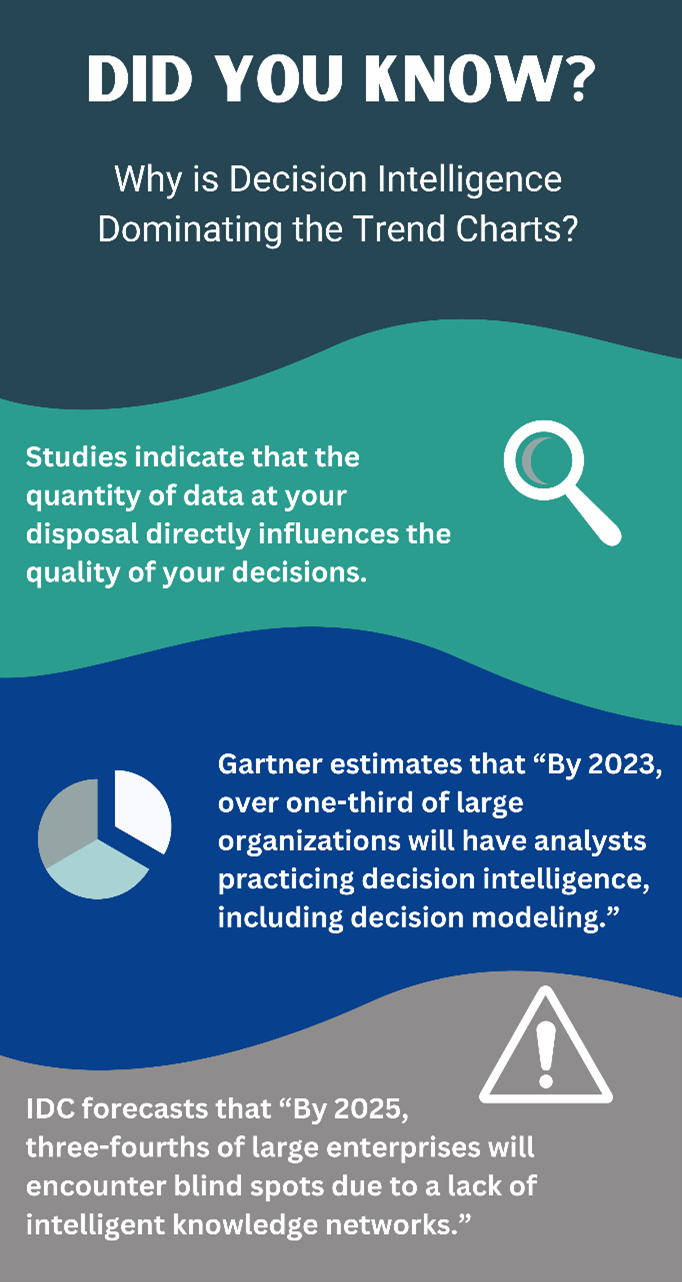
Think of how much data you deal with daily - multiple projects, team dynamics, shifting priorities, budget constraints, and looming deadlines. It can feel like you’re constantly juggling priorities without always knowing which move will have the best outcome. DI is designed to help with exactly that—it brings all of these data points into a unified view, analyzing them to give you actionable insights. This means you’re no longer simply reacting to issues after they happen; you can proactively prevent problems before they even arise.
Key Elements of Decision Intelligence
To understand how Decision Intelligence adds value, let’s break it down into its core elements, each of which plays a crucial role in making DI so effective:
- Data Aggregation and Integration - DI collects data from various sources, such as your project management software, financial systems, and resource allocation tools. By aggregating this data into one place, it provides a comprehensive view, helping project managers make well-informed, holistic decisions.
- Predictive Analytics - This element leverages machine learning algorithms to analyze both historical and real-time data. The result? A forecast of future outcomes that helps you mitigate risks before they become crises.
- Closed-Loop Learning - A significant advantage of DI is its ability to learn from the outcomes of past decisions. This continuous feedback loop ensures the system becomes more intelligent and accurate over time, adapting to new variables as they emerge.
By integrating these elements, DI becomes an essential tool in navigating complex projects with greater confidence, speed, and accuracy.
Below is an illustration of the decision intelligence model.
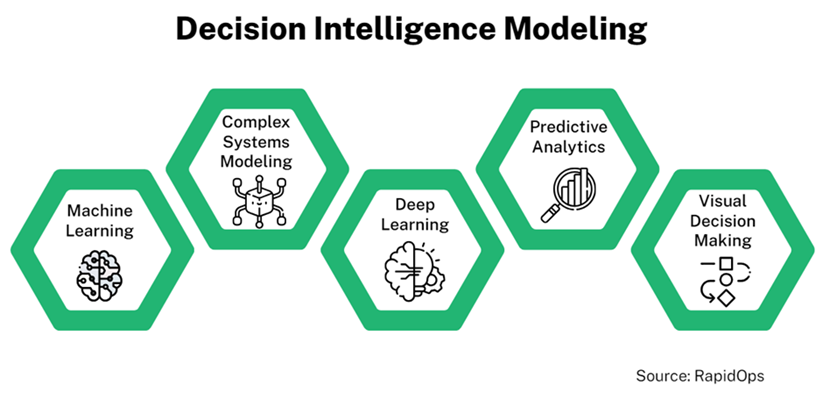
How Decision Intelligence Is Reshaping Project Management
Decision Intelligence has emerged as a game-changer, offering substantial benefits to project managers across industries. So, what makes it so powerful, and how does it fit into everyday project management?
- Optimized Resource Allocation - Every project manager knows the importance of allocating resources effectively. DI helps by analyzing factors such as team performance, available resources, and project scope. It provides recommendations that ensure resources are used efficiently, leading to on-time delivery with minimal waste.
- Real-Time Decision-Making - Traditional project management methodologies often involves making decisions based on periodic reports. But in fast-paced environments, these reports may become outdated quickly. DI, on the other hand, uses real-time data to help project managers respond instantly to challenges like supply chain disruptions or changing client requirements. This agility is key to maintaining project momentum in today’s fast-moving industries.
- Enhanced Risk Management - One of the standout features of DI is its ability to predict risks before they materialize. In sectors like construction, where unforeseen delays can lead to massive cost overruns, DI systems can forecast delays caused by factors such as weather or logistical issues, giving managers time to adjust schedules and budgets.
- Financial Forecasting - Managing budgets can feel like walking a tightrope—one wrong step, and costs can spiral out of control. DI helps prevent this by analyzing spending patterns and predicting future financial needs, giving project managers the ability to make corrective actions long before budget overruns occur.
In a data-driven world, organizations grasp the pivotal role of data in maintaining competitive advantage, meeting customer demands, fostering innovation, and adapting to dynamic landscapes. However, traditional models falter when bridging data and real-world behaviors. DI is a transformative force that bridges this gap.
Machine learning and AI fuel decision intelligence, empowering organizations to enhance decision-making. By infusing data-driven insights, it sharpens project outcomes, mitigates risks, and fosters efficiency. Moreover, it upholds human expertise, ensuring smarter decisions and superior results. In this era of change, DI is your compass, guiding you toward success.
The image below depicts the seven primary technology clusters driving these emerging trends.
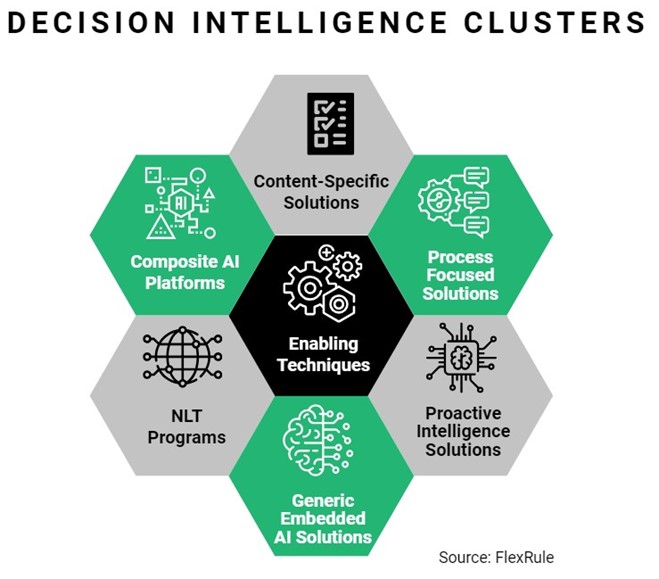
How Predictive Intelligence Enhances Decision Intelligence
At the heart of DI lies predictive intelligence. The element turns decision intelligence from a reactive tool into a proactive one. Using machine learning models, predictive intelligence analyzes past project data and real-time information to predict future trends, challenges, and opportunities.
Let’s say you’re managing a large-scale IT infrastructure project. Predictive intelligence can help you model potential supply chain disruptions or forecast whether a key supplier might face delays, allowing you to develop alternative strategies before a bottleneck occurs. This predictive capability can be applied across various aspects of project management, from timelines to budget forecasting and even customer behavior analysis.
Imagine being able to forecast how your project’s budget will hold up based on spending trends or knowing how market shifts might influence your product development timelines. With predictive intelligence, project managers can adjust their strategies early in the lifecycle, preventing costly setbacks.
The below graphic is based on information available at Peak sourced from IDC Report based on survey results from various industries.
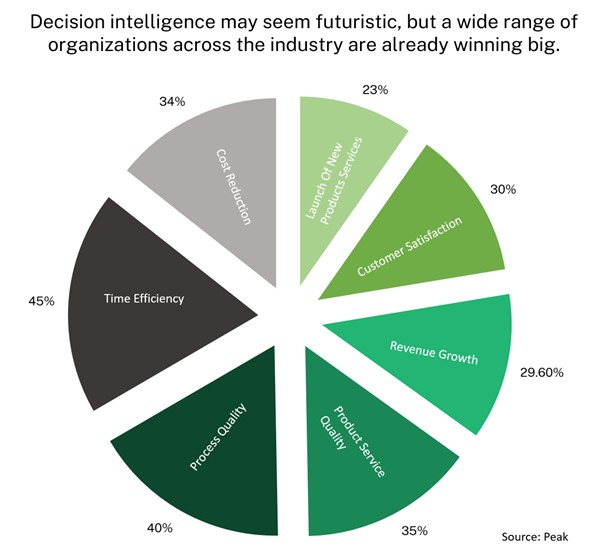
Advantages of Implementing Decision Intelligence
With AI-powered solutions, organizations can propel successful project outcomes by leveraging predictive intelligence and decision augmentation capabilities. Here are some transformative benefits:
- Predictive Insights - AI extracts meaningful patterns from data and builds self-evolving models to accurately predict project outcomes, enabling data-driven decision-making.
- Scalable Decision-Making - Decision Intelligence empowers organizations to derive insights from vast data sets, enabling quicker and more cost-effective decision-making by accurately assessing project health and status.
- Reduced Analytical Backlog - Automation alleviates laborious analytical tasks, fostering collaboration, efficient workflows, and improved project success rates.
- Elimination of Internal Silos - Decision Intelligence systems integrate data for uniform insights, breaking down silos and providing a holistic view for informed, goal-aligned decisions.
- Democratization of Decision - Making - Decision Intelligence makes predictive analytics accessible to business decision-makers, ensuring insights are distributed across the organization for better-informed choices and successful project outcomes.
- Bias Mitigation - AI solutions aid in identifying and understanding biases in project data, preventing them from adversely affecting outcomes, regardless of data volume.
- Improved Project Success and Business Growth - By facilitating data-driven decision-making, AI solutions enhance project success and business growth. They leverage vast data sets to identify risks, explore outcomes, and develop effective strategies, leading to improved results and increased revenue.
The below graphic is based on information available at Allerin.
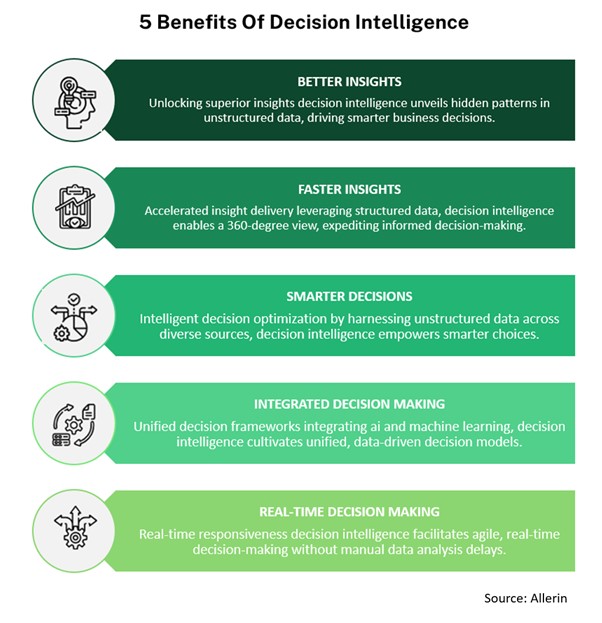
Conclusion
As business challenges grow, decision intelligence (DI) has become a vital tool in project management. By integrating predictive analytics, real-time data, and AI-driven insights, project managers can shift from reactive to proactive decision-making, improving risk mitigation, resource optimization, and project outcomes.
At the heart of DI, predictive intelligence enables managers to foresee and address potential issues before they impact projects. This foresight ensures projects stay on track, within budget, and aligned with business goals.
For organizations seeking to maximize their project potential, TrueProject offers unparalleled solutions. TrueProject sets itself apart as a KPI-based predictive intelligence SaaS solution that’s uniquely designed to enhance decision-making throughout the project lifecycle. By delivering real-time, data-driven insights, it allows project managers to not only identify risks early but also anticipate resource needs and budgetary constraints with precision.
TrueProject’s predictive models continuously adapt, offering proactive recommendations that align with specific project goals and business objectives, ensuring that decisions are both informed and strategic. Its derived insight capabilities integrate all critical project data into a single source of truth, enabling seamless collaboration and a holistic view of project health. With TrueProject, decision-makers gain confidence in navigating complex projects, knowing that every choice is backed by AI-powered analytics tailored to optimize outcomes and drive sustainable success.
More information on TrueProject at trueproject.com
Endnotes
- TP&P Content Team. “Decision Intelligence & Its Importance In The Digital Age.” TP&P: Mar 20, 2023. https://www.tpptechnology.com/en/blog/decision-intelligence-its-importance-in-the-digital-age/
- BDO Content Team. “What Is Decision Intelligence and How Can Companies Use It?” BDO: Mar 16, 2023.
- Mohammad Waqar. “How Decision Intelligence is Key to Digital Transformation” Galvia: Jul 10, 2023. https://galvia.ai/blog/how-decision-intelligence-is-key-to-successful-digital-transformation/
- Rapid Ops Team. “Decision Intelligence – What Is It and How Could It Democratize Analytics. Rapid Ops: (n.d). https://www.rapidops.com/blog/decision-intelligence-what-is-it-and-how-could-it-democratize-analytics/
- Mex Emini. “Why Decision Intelligence Is The Next Digital Transformation.” Forbes: Sep 16, 2022. https://www.forbes.com/sites/forbestechcouncil/2022/09/16/why-decision-intelligence-is-the-next-digital-transformation/?sh=6d878f875ba9
- Arash Aghlara. “Decision Intelligence by Gartner – A New Category is Born.” FlexRule: Mar 17, 2022. https://www.flexrule.com/archives/decision-intelligence-new-category/
- Naveen Joshi. “5 Benefits and Use Cases of Decision Intelligence.” Allerin: Jan 29, 2023. https://www.allerin.com/blog/5-benefits-and-use-cases-of-decision-intelligence
- Richard Potter. “It’s time to level up your organization with decision intelligence.” IDC Report: Level up your organization with Decision Intelligence.” https://peak.ai/hub/guides/idc-level-up-your-organization-with-decision-intelligence/






